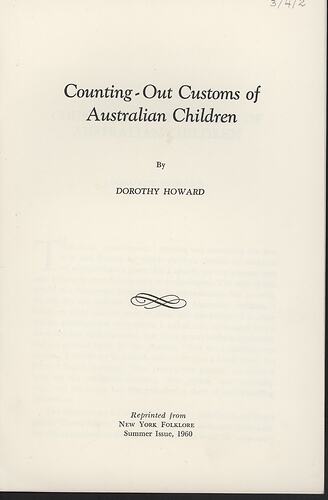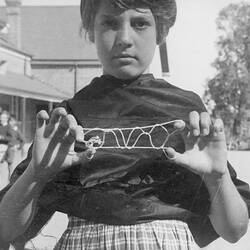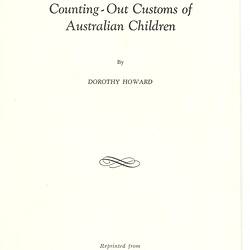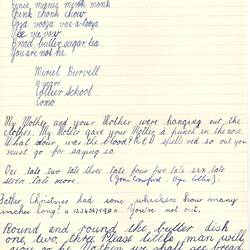There are many rituals children have used over time to select this role and some are centuries old.
In the mid-1950s Dr Dorothy Howard, an American Fulbright Scholar, undertook an eight-month study tour documenting Australian children's traditional play lore including counting out processes. Howard identified that boys preferred 'selective' rituals which were quick and decisive such as racing to a wall or tossing a coin. Girls, on the other hand, commonly used counting out rhymes where one player is eliminated each time the rhyme is completed. This method takes longer to complete and is controlled by the person who is 'counting out' the rhyme. Here are some examples:
Tic, Tac, Toe, here we go, where I land I do not know.
Little Miss Piggy fell down the sink, how many miles did she fall.
Ip, dip, dog shit one, two, three
Howard also observed that children almost always used the term 'You're He' rather than 'You're It'. These days children mostly use the term 'You're It'; 'You're He' would be a rarity. This change exemplifies the changing language and lore of childhood over time, appearing to change in line with social expectations but keeping constant the underlying traditions and rituals.
In the late 1970s, inspired by Howard's collecting work, Dr June Factor tasked her early childhood education students to go out to primary schools and collect rhymes, games and rituals from children during their playtime. Thousands of items of playlore were collected on filing cards which are housed in the Australian Children's Folklore Collection. These cards provide an impressive window into primary school children's playlore between roughly 1976 to late 1980s in Victoria.
Under the heading of Counting Out Rhymes there are approximately 900 entries. Interestingly the same counting out rhymes noted by Howard as the most popular - One Potato Two Potato and Eeny Meeny Miney Mo - retained their top positions in the 1970s/80s collection. In both the Howard and Factor collections the use of the 'n-' word in Eeny Meenie Miney Mo appeared in almost every entry for this rhyme. Moving forward to the 'Childhood, Tradition and Change' Australian Research Council-funded project in 2011 (with Melbourne, Deakin and Curtin Universities, the National Library of Australia and Museum Victoria), Eeny Meeny Miney Mo was recorded in only three of the 19 schools, and in each case Eeny Meeny 'chased a tigger by the toe'. Again this demonstrates both the constancy of oral traditions in childhood and its responsiveness to changing social norms.
Counting out rituals from southeast Asia
In the mid-1980s, studies of children's play in multicultural primary school playgrounds in inner Melbourne revealed a different way of counting out. Many of these inner suburban schools had a high proportion of children from culturally diverse backgrounds, mostly children whose families migrated from southeast Asia and Turkey.
In 1984 Heather Russell observed children's playground games and rituals in one such school over a four-week period as part of the project Play and Friendships in a Multicultural Playground (see 'Play and Friendships in a Multicultural Playground').
Russell observed widespread use of a ritual used to decide who is It, called 'Aw Sum' (also referred to as 'Black and White'). This ritual appeared to originate from children who were born in Vietnam with either Vietnamese or Chinese heritage, and in Laos and Timor. Aw Sum is a two-step process:
Step 1:A circle of children stand around and chant Aw (sounding Or) Sum. On the word 'Sum' everyone puts one hand into the middle either palm up (white) or palm down (black). Whichever option is lesser eliminates those children. This is repeated until one or two children are left.
Step 2: If two players are left, they play-off with three rounds of 'Paper, Scissors, Stone'. The loser after three attempts, is 'It'.
Non-verbal elimination rituals such as Aw Sum are certainly quicker and less open to manipulation when there is no common first language. The popularity of Aw Sum and its acceptance across the diverse community of children in this playground is testimony to children's adaptiveness in the interest of making decisions where everyone is an equal participant.
Darian-Smith K. & Henningham, N., 2011. Final Report of the Childhood, Tradition and Change Project.
Howard, D., 1960. 'Counting - Out Customs of Australian Children'. Reprinted from New York Folklore in Darian-Smith, K. and Factor, J., 2005. Child's Play, pp. 123-140.
Russell, H., 1986. Play and Friendships in a Multicultural Playground. Australian Children's Folklore Publications, Melbourne.
More Information
-
Keywords
-
Localities
-
Authors
-
Article types





